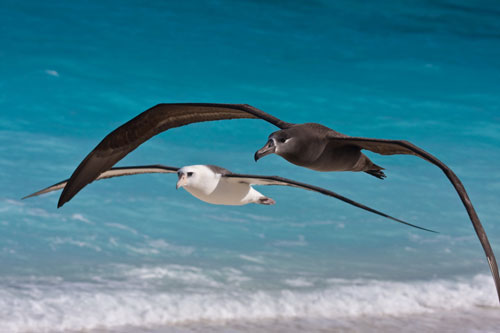Scientists recently completed a journey into the vast and little-explored "Great Pacific Ocean Garbage Patch" which is thought to be the source of much of the plastic ingested by Black-footed, Laysan and Short-tailed Albatrosses.

On the Scripps Environmental Accumulation of Plastic Expedition (SEAPLEX), researchers got the first detailed view of plastic debris floating in a remote ocean region. The expedition was led by a team of Scripps Institution of Oceanography (SIO) graduate students, with support from University of California Ship Funds, the National Science Foundation (NSF) and Project Kaisei.
The Scripps research vessel R.V. New Horizon left its San Diego homeport on 2 August 2009, for the North Pacific Ocean Gyre, located some 1000 miles off California's coast, and returned on 21 August. Scientists surveyed plastic distribution and abundance, taking samples for analysis in the lab and assessing the impacts of debris on marine life.
Before this research, little was known about the size of the "garbage patch" and the threats it poses to marine life and the gyre's biological environment. After transiting for six days aboard the research vessel, the researchers reached their first intensive sampling and began 24-hour sampling periods using a variety of tow nets to collect debris at several ocean depths.
"We targeted the highest plastic-containing areas so we could begin to understand the scope of the problem," said Miriam Goldstein of SIO, chief scientist of the expedition. "We also studied everything from phytoplankton to zooplankton to small midwater fish." The scientists found that at numerous areas in the gyre, flecks of plastic were abundant and easily spotted against the deep blue seawater.
Black-footed and Laysan Albatrosses in particular are well known for their tendency to ingest plastic items and feed these to their chicks. However, it is unclear how often albatrosses encounter or ingest plastic, whether plastic is mistaken for prey, has natural food attached to it, or is consumed to assist in digestion as is sometimes done with pumice. Unfortunately, plastic ingestion leads to mechanical blockage of the digestive tract, reduced food consumption, satiation of hunger, and potential exposure to toxic compounds. Although there have been documented detrimental effects on the growth rates and fledging masses of chicks, it is still unclear what levels of mortality are caused by plastic ingestion and further work should focus on answering these questions.
Adapted from materials provided by the National Science Foundation. Click here for more information.
Lindsay Young, North Pacific New Correspondent, 15 October 2009

 English
English  Français
Français  Español
Español